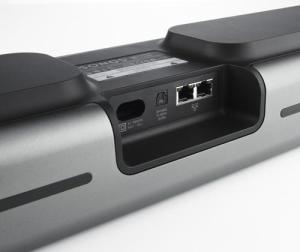Without a doubt the Sonos Playbar sounds better with added surround speakers (and subwoofer) that it does solo. But the Playbar is still hobbled by a design limitation it shares with most other soundbars. Unless you are the rare person who uses your HDTV to receive off-air digital television with a real antenna receiving signals from through the air, you are most likely feeding dumbed-down 2-channel audio from all your sources to your shiny new Playbar.
Most modern surround sound is in 5.1 format – 5 distinct full-range channels plus a bass channel. When your TV plays off-air channels you get the 5.1 audio supplied with most major network broadcasts. When you use a cable box, DVR, TiVo, Blu-Ray, DVD, Roku, Apple TV or whatever source connected by HDMI cable to your TV, the TV in turn mixes the surround sound down to a 2-channel rendition played on the TV’s own speakers and sent out the digital audio output, and in turn to your soundbar. The optical digital cable can convey 5.1 audio but it doesn’t matter because the TV generally isn’t sending it. Sorry, there isn’t a setting you can use to fix this, 98% of the time.
So does this matter with a soundbar?
Yes, a lot, as it turns out. The Playbar does do surround decoding on the 2 channel source but the results are limited. On the other hand, the Playbar alone (as well as with the surround speakers and sub) benefits enormously from a proper 5.1 channel source.
The best solution requires a soundbar with HDMI switching. Rather than using your TV as a switching hub, with all sources connected to directly to it, use a soundbar or other home theater system that does proper HDMI switching, stripping off and playing the 5.1 audio. Now the soundbar is the switching hub where you choose your input, and just a single cable transfers the picture onward to the TV.
In the case of the Sonos Playbar and similar soundbars that have only an optical (or coaxial) digital input, the only work-around is a bit inelegant but effective. Run a separate digital cable from your favorite source directly from the source to the Playbar. In my case, I use a TiVo box for cable channels and Netflix. The TiVo connects to the TV by HDMI, carrying picture and 5.1 sound. In addition, I run a separate optical digital cable from the TiVo box directly to the Sonos digital input. Now the Sonos gets the 5.1 audio that the TV won’t supply.
Does it sound great?
Yes, it’s more spacious, is clearer, and has more punch than the same program coming in as 2-channel. However, it doesn’t solve the audio problems with the Playbar I described in a recent post. Is it a little messy? Yes, in particular because the TiVo runs all the time and sends out audio even when the TV itself is off. So a switching plug strip is needed to let you turn off the Playbar. The set-up will work better if a disc player or media player is the source, as these are likely off when not in use.
I did start out by saying this was inelegant. Do you want the best sound? For any source with an HDMI and separate digital audio output, you can do this. This solution is not unique to the Playbar – in fact you can use the trick to improve most soundbars that lack HDMI connectivity.
© 2016 Stephen Shenefield


Pingback: How to Play Hi-Res Audio Files on Sonos | Vaetr Design
So hre I am the RARE person who does NOT use cable and has a real antenna. The antenna is plugged into the tv an optical cable goes from the TV to the soundbar. How do I “strip” this out so the sound is true 5.1?
Actually there’s a high likelihood you will get 5.1 without doing anything… BUT it is also possible you will need to go into the audio settings for the TV and turn on 5.1 output. This might be a matter of switching from PCM (which is 2-channel that is matrix a.k.a. Dolby Pro Logic encoded) to Dolby Digital (which is the standard for digital television). If this choice is provided you will definitely hear the difference for a show that is 5.1. Note that some shows, like older re-runs, might be Dolby 1.0 or 2.0 (DD allows for all sorts of combinations of channels) so you should look at something recent to hear the difference.
I have an Apple TV 4K connected to my LG OLED TV via an HDMI cable. When a programme offers Dolby Digital sound it displays on the TV screen so I know the TV is receiving it. There is an optical cable from my TV to the Sonos Playbar and I am hoping it is sending 5.1 to it. How can I confirm this? I have a Sonos sub and two Play 1s acting as the rear speakers.
Ethan – thanks for your question. Unfortunately, it can be tricky to definitively determine that 5.1 audio is being sent out from the TV, even if you know the TV is receiving 5.1 on an input. The only trick I can think of is borrow an AV Receiver that displays what it is receiving — I have a Denon that says on its display which channels are coming through. This is a cumbersome kind of test to run, of course!